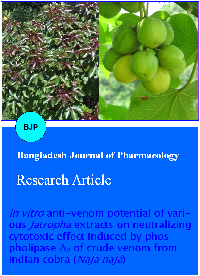In vitro anti-venom potential of various Jatropha extracts on neutralizing cytotoxic effect induced by phospholipase A2 of crude venom from Indian cobra (Naja naja)
DOI:
https://doi.org/10.3329/bjp.v9i1.17410Keywords:
Antidote, Cytotoxicity, Jatropha, PLA2, Snake venomAbstract
In present study various species of Jatropha were evaluated for antidote nature induced by phospholipase A2 (PLA2) cobra venom. Although qualitative phytochemical analysis exhibited less variation across Jatropha species studied, substantial variability in terms of PLA2 inhibition by various solvent extracts across the species and between different parts of same plant was observed. Among all samples methanolic extracts of J. gossypifolia leaf showed highest inhibition of PLA2 toxicity while some aqueous extracts of J. foetida and all aqueous extracts of J. curcas, enhanced PLA2 activity. Present results highlight Jatropha not only as rich source of secondary compounds with antidote property for snake bite but also potent toxic agents as revealed with increased hemolysis by some aqueous extracts of J. curcas and J. foetida. Our findings suggest that methanolic leaf extract of J. gossypifolia contain potent small molecular antagonist(s) to the snake venom PLA2 which will be very useful to design adjuvant therapies in treatments of snake bites.
Downloads
583
316 Read
37
References
Albuquerque UP. Re-examining hypotheses concerning the use and knowledge of medicinal plants: A study in the caatinga vegetation of NE Brazil. J Ethnobiol Ethnomed. 2006; 2: 30.
Chiou YL, Shinne R, Wan PH, Long SC. Quercetin modulates activities of Taiwan Naja naja naja phospholipase A2 via its effects on membrane structure and membrane-bound mode of phospholipase A2. J Biosci. 2012; 37: 277-87.
Condrea E, Yang CC, Rosenberg P. Comparison of relatively toxic phospholipase A2 from Naja nigricolis snake venom with that of relatively non toxic Phospholipase A2 from Hemachatus heamachatus snake venom-I. Enzymatic activity on free and membrane bound substrate. Biochem Pharmacol. 1980; 29: 1555-63.
Condrea E, Fletcher JE, Rapuano BE, Yang CC, Rosenberg P. Dissociation of enzymatic activity from lethality and pharmacological properties by cabonylation by lysines in Naja nigrocolis and Naja naja atra snake venom phospholipase A2 . Toxicon 1981; 19: 705-20.
Gutierrez JM, Avila C, Rojas E. An alternative in vitro method for testing the potency of the polyvalent antivenom produced in Costa Rica. Toxicon 1988; 26: 411-13.
Habermann E, Neumann W. Egg yolk coagulation method. Physiol Chem. 1954; 297: 174.
Harborne JB. Photochemical methods: A guide to modern techniques of plant analysis. London, Chapman A. & Hall, 1998.
Jiang MS, Fletcher JE, Smith LA. Factors influencing the hemolysis of human erythrocytes by cardiotoxins from Naja naja kaouthia and Naja naja atra venoms and a phospholipase A2 with cardiotoxin-like activities from Bungarus fasciatus venom. Toxicon 1989; 27: 247-57.
Kini RM, Iwanga S. Structure-function relationship of phospholipase 1: Prediction of presynaptic neurotoxicity. Toxicon 1986; 24: 527-41.
Mebs D, Samejima J. Purification from Austalian elapid venoms and properties of phospholipase A which causes myoglobinurea in mice. Toxicon 1980; 18: 443-54.
Nazim MH, Gupta S, Hashmi S, Zuberi J, Wilson A, Roberts L, Karimi K. Retrospective review of snake bite victims. W V Med J. 2008; 104: 30-34.
Panfoli I, Calzia D, Ravera S, Morelli A. Inhibition of hemorrhagic snake venom components: Old and new approaches. Toxins 2010; 2: 417-27.
Paula DR, Sanchez EF, Costa TRMartins CHG, Pereira PS, Lourengo MV, Soares AM, Fuly AL. Antiophidian properties of plant extracts against Lachesis muta venom. J Venom Anim Toxins Incl Trop Dis. 2010; 16: 311-23.
Sofowora A. Medicinal plants and traditional medicines in Africa. New York, John Wiley & Sons, 1993, pp 97-145.
Trease GE, Evans WC. A textbook of pharmacognosy. 14th ed. London, Bailliere Tindall Ltd., 1996.
Vishwanath BS, Kini, RM, Gowda TV. Characterization of three edema-inducing phospholipase A2 from Vipera russelli venom and its interaction with aristolic acid. Toxicon 1987; 25: 501-15.

Published
How to Cite
Issue
Section
License
Authors who publish with this journal agree to the following terms:
- Authors retain copyright and grant the journal right of first publication with the work simultaneously licensed under a Creative Commons Attribution License that allows others to share the work with an acknowledgement of the work's authorship and initial publication in this journal.
- Authors are able to enter into separate, additional contractual arrangements for the non-exclusive distribution of the journal's published version of the work (e.g., post it to an institutional repository or publish it in a book), with an acknowledgement of its initial publication in this journal.
- Authors are permitted and encouraged to post their work online (e.g., in institutional repositories or on their website) prior to and during the submission process, as it can lead to productive exchanges, as well as earlier and greater citation of published work (See The Effect of Open Access).
